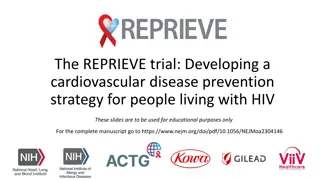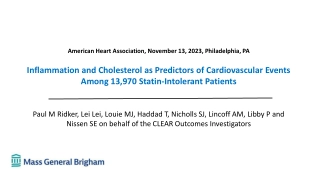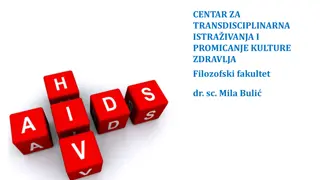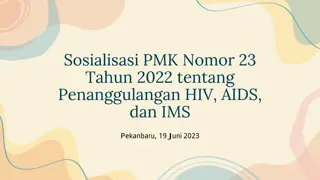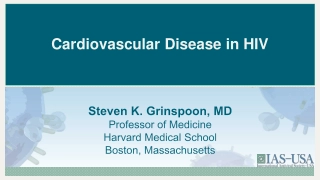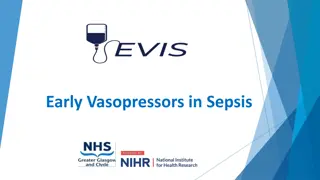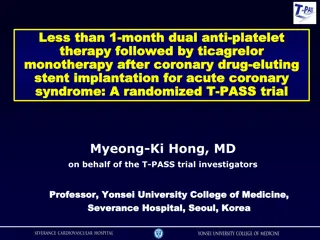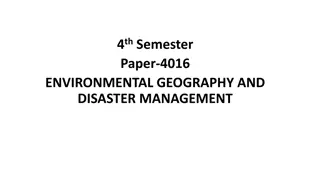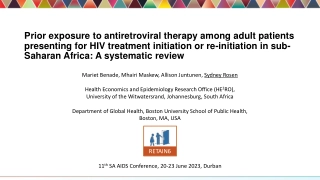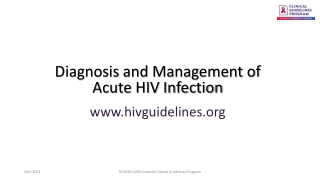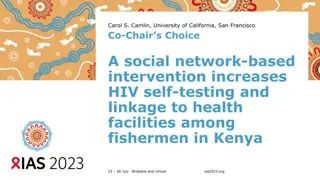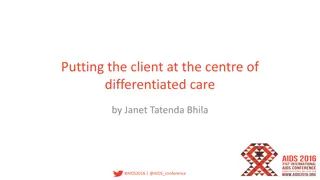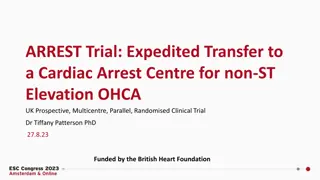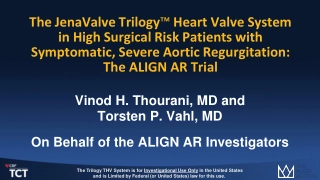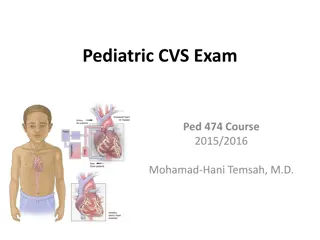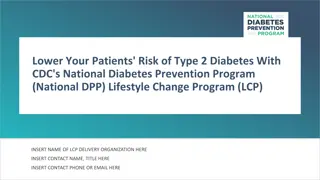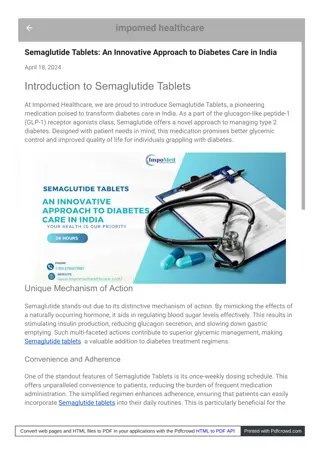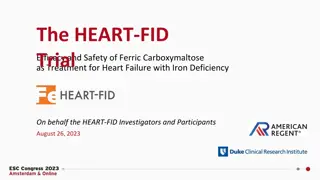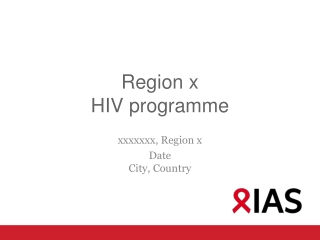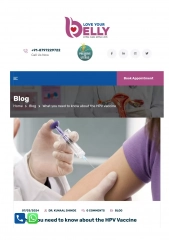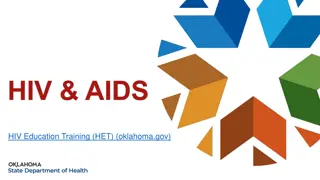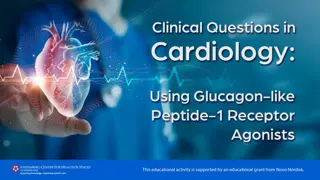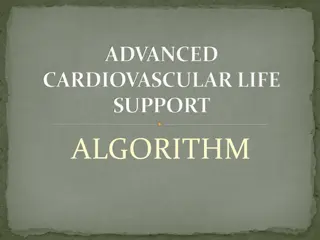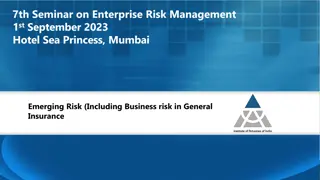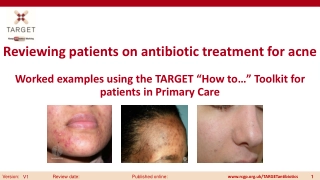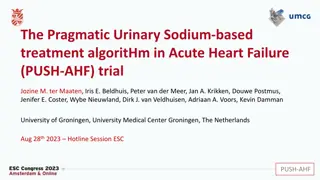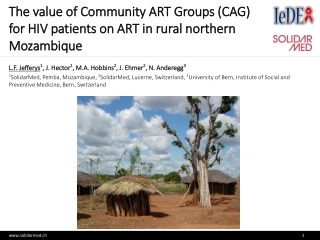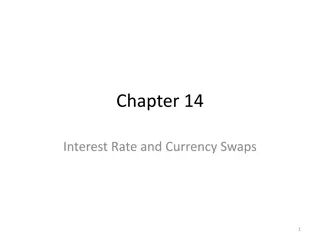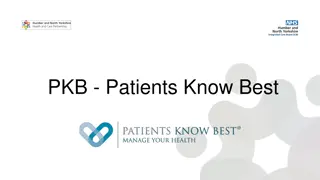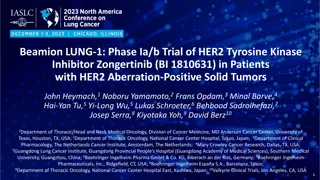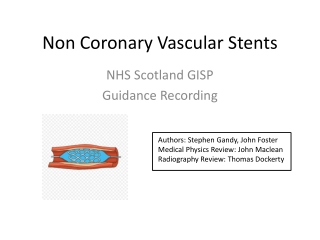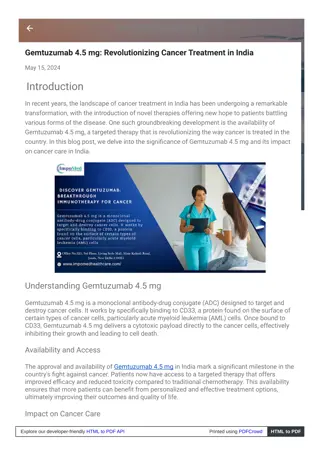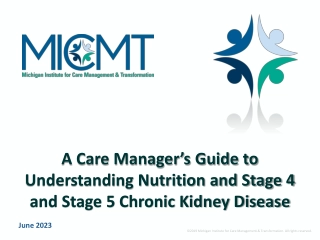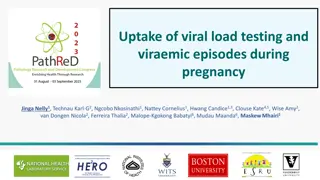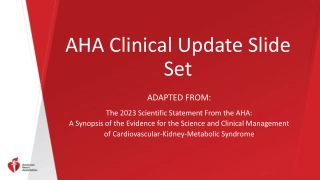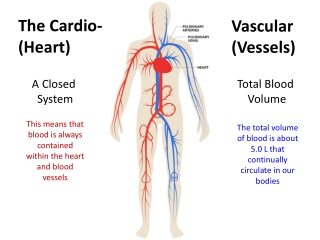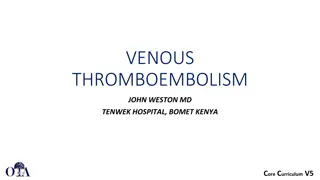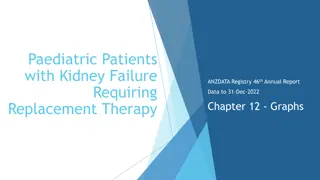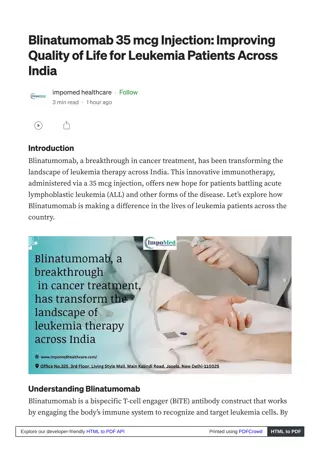Insights from the REPRIEVE Trial for Managing Cardiovascular Risk in Patients with HIV
Cardiovascular disease is a growing concern in individuals living with HIV, despite advancements in treatment. The REPRIEVE Trial sheds light on the importance of assessing cardiovascular risk and implementing primary prevention measures in this population. Dr. Grinspoon's financial disclosures and the learning objectives of the trial are highlighted. Poll questions address the evaluation of cardiovascular risk and provision of comprehensive care for HIV patients, emphasizing the need for proactive management strategies. The study rationale underscores the persistent comorbidity gap in HIV populations and the potential of statins like pitavastatin to mitigate cardiovascular risk factors beyond traditional approaches.
Insights from the REPRIEVE Trial for Managing Cardiovascular Risk in Patients with HIV
PowerPoint presentation about 'Insights from the REPRIEVE Trial for Managing Cardiovascular Risk in Patients with HIV'. This presentation describes the topic on Cardiovascular disease is a growing concern in individuals living with HIV, despite advancements in treatment. The REPRIEVE Trial sheds light on the importance of assessing cardiovascular risk and implementing primary prevention measures in this population. Dr. Grinspoon's financial disclosures and the learning objectives of the trial are highlighted. Poll questions address the evaluation of cardiovascular risk and provision of comprehensive care for HIV patients, emphasizing the need for proactive management strategies. The study rationale underscores the persistent comorbidity gap in HIV populations and the potential of statins like pitavastatin to mitigate cardiovascular risk factors beyond traditional approaches.. Download this presentation absolutely free.
Presentation Transcript
Results From the REPRIEVE Trial: Implications for the Clinical Care of Patients With HIV Steven K. Grinspoon, MD Professor of Medicine Chief, Metabolism Unit Massachusetts General Hospital Harvard Medical School Boston, MA
Financial Relationships With Ineligible Companies (Formerly Described as Commercial Interests by the ACCME) Within the Last 2 Years Dr Grinspoon reported receiving research funding from Kowa Pharmaceuticals America, Inc, Gilead Sciences, Inc, and ViiV Healthcare; serving as a consultant for Theratechnologies; and serving as a consultant and on the scientific advisory board for Marathon Asset Management. (Updated October 17, 2023) Slide 2
Learning Objectives On completion of this activity, learners will be able to: Describe the results of the REPRIEVE (Randomized Trial to Prevent Vascular Events in HIV) trial in people with HIV Monitor people with HIV for cardiovascular disease and determine the optimal use of primary prevention measures Slide 3
Poll Question #1 At the current time, do you routinely assess for cardiovascular risk in your patients with HIV without any symptoms or history of cardiovascular disease? A. Yes B. No Slide 4
Poll Question #2 Do you provide comprehensive primary care to the people with HIV in your practice? A. Yes B. No Slide 5
Cardiovascular Disease is Increasing in PWH, Contributing to a Persistent Comorbidity Gap POPULATION WITH HIV PWOH, total yrs PWH, total yrs PWOH, comorbidity free yrs PWH, comorbidity free yrs Marcus et al., JAMA Network Open 2020; Feinstein et al., Am J Card 2016 Slide 6
Study Rationale PWH demonstrate increased cardiovascular disease (CVD) (50-100%) and excess plaque controlling for traditional risk, even at a young age ART reduces comorbidities (SMART) but residual immune activation persists, even with good viral suppression - ART alone is not sufficient to prevent CVD Statins lower LDL cholesterol, a main driver of CVD in PWH, but also residual immune activation and inflammation, including among PWH Pitavastatin is a moderate intensity statin, unaffected by ART, with good LDL and anti-inflammatory properties We hypothesized pitavastatin would prevent MACE through these effects in PWH, at low to moderate risk, for whom statins not typically prescribed under current guidelines MACE = major adverse cardiovascular events Slide 7
REPRIEVE Study Population Inclusion Criteria Documented HIV Receiving stable ART CD4+ > 100 cells/mm3 Age 40 years, 75 years No known atherosclerotic cardiovascular disease (ASCVD) 10-yr ASCVD risk score <7.5% LDL < 190 mg/dL 7.5% and 10% LDL, < 160 mg/dL >10% and 15%, LDL < 130 mg/dL Certain laboratory parameters Exclusion Criteria Current use of statins, gemfibrozil, or PCSK9 inhibitors Known decompensated cirrhosis Note: For LDL, to convert from mg/dL to SI (in mmol/L) multiply by 0.02586 Slide 8
REPRIEVE Trial Schema Screening and Consent Asymptomatic PWH on ART, with low-moderate ASCVD risk Time R N=7769 Randomization Intervention Pitavastatin Placebo Mechanistic SubStudy N=805, 2 yrs Mechanistic Primary Endpoint Coronary plaque, vascular Inflammation, immune activation Clinical Primary Endpoint CVD Death Unstable Angina Arterial Revasc PAD MI TIA & Stroke Individual components of primary endpoint and all cause mortality Secondary Endpoints Predictors of statin effects Inflammatory, immunological, metabolic biomarkers Statin safety and non AIDS comorbidities, DM, infections, cancer Slide 9
Global Enrollment Slide 10
Baseline Characteristics Age (years) Natal sex Total (N=7769) Pitavastatin (N=3888) Placebo (N=3881) Median (Q1 Q3) Male Female Cisgender Transgender spectrum Not reported White Black/African American Asian Median (Q1 Q3) < 50 50-199 200 < LLQ LLQ - < 400 400+ Missing Median (Q1 Q3) Median (Q1 Q3) 50 (45-55) 5350 (69%) 2419 (31%) 7367 (95%) 127 (2%) 275 (4%) 2704 (35%) 3208 (41%) 1138 (15%) 621 (448-827) 1409 (18%) 2392 (31%) 3706 (48%) 5250 (88%) 617 (10%) 130 (2%) 1772 4.5 (2.1-7.0) 108 (87-128) 50 (45-55) 2677 (69%) 1211 (31%) 3687 (95%) 63 (2%) 138 (4%) 1634 (35%) 1569 (40%) 571 (15%) 620 (449-832) 688 (18%) 1202 (31%) 1859 (49%) 2641 (88%) 305 (10%) 63 (2%) 879 4.5 (2.1-7.0) 109 (87-128) 50 (45-55) 2673 (69%) 1208 (31%) 3680 (95%) 64 (2%) 137 (4%) 1340 (35%) 1639 (42%) 567 (15%) 622 (445-824) 721 (19%) 1190 (31%) 1847 (47%) 2609 (87%) 312 (10%) 67 (2%) 893 4.5 (2.2-7.0) 108 (87-127) Gender identity Race CD4 count (cells/mm3) Nadir CD4 count (cells/mm3) HIV RNA (Copies/mL) ASCVD risk score, (%) LDL-C (mg/dL) Slide 11
Baseline ART Regimen and Duration Slide 12
Recent ART Regimen and Duration REPRIEVE is an events driven trial with 85% power to detect a HR of 0.70 with 288 planned events The DSMB convened at 75% of information and closed the trial for efficacy, concluding there were no unanticipated safety concerns and that the benefits outweighed the risk of statin therapy in this group DSMB = data and safety monitoring board Slide 13
Primary and Key Secondary Endpoints -35% vs Placebo -21% vs Placebo Slide 15
Additional Findings Greater than 80% in both groups remained in follow-up Adherence was verygood to excellent in the great majority of participants Adverse event-related discontinuation was low in each group (2% vs 1% pitavastatin vs placebo) Clinical initiation of a non-study statin occurred in 5.7% pitavastatin and 9.6% of placebo-treated participants, below the threshold of concern All events adjudicated vis a vis relationship to COVID; only one MACE event definitely related Slide 16
Effects on Key Subgroups Very consistent effect across major subgroups No treatment modification based on LDL, age, sex Generally consistent effects across race and GBD regions No treatment modification based on CD4, nadir CD4, HIV RNA, ART Duration GBD = global burden of disease Slide 18 Slide 18
Effects on LDL and NON-HDL Cholesterol 30% reduction in LDL in pitavastatin group, no change in placebo Durable effect over time Pitavastatin Placebo Slide 19
Effect Larger than Anticipated Based on Lowering of LDL REPRIEVE LDL lowering matters but statin effect is beyond what is expected for LDL lowering alone Predicted 17% Note: 35% is point estimate, CI % is 17 52% Lancet 2010; 376: 1670-81 Slide 20
Safety DSMB concluded no unanticipated safety concerns Serious adverse events similar in each group: IRR 1.02 (0.92-1.14) Muscle-related symptoms were higher in the pitavastatin group (2% vs. 1% in placebo) but were mostly mild and only 1% withdrew for muscle-related symptomatology Diabetes rates increased in the pitavastatin group (5.3% vs 4.0% in placebo), but this increase was consistent with that seen in prior statin studies, was not significantly above rates demonstrated for the general population, and protective effect of MACE seen among those with DM No effect on Grade 3 ALT or rhabdomyolysis was seen IRR: incidence rate ratio Slide 21
How Might the Findings of REPRIEVE Impact the Recommendations for Statin Therapy (2019 ACC/AHA Guidelines)? HIV was recently considered a risk enhancer, but its use in primary prevention had not been studied Previously unknown if PWH with low to moderate risk should be put on a statin and whether statin therapy would be successful in this context? REPRIEVE has taught us that yes this is the case, statin therapy will prevent MACE in low to moderate risk PWH Slide 22
5-Yr Number Needed To Treat (NNT) to Prevent One MACE Event Increasing CVD with increasing ASCVD risk score Decreasing NNT with increasing ASCVD risk score NNT = number needed to treat Slide 23
Womens Enrollment in REPRIEVE Main Study % Women among population living with HIV, by country 23a 29b 18c 34d 24c 57c 42c 39e % Women enrolled in REPRIEVE, by country 23 10 9 29 8 42 56 26 US Canada Spain Brazil Peru Haiti Thailand India South Africa Participation to prevalence ratio: 66 64c >0.7 .5-0.7 <0.5 63 61c Botswana 51 60c Uganda a. b. c. d. e. HIV/AIDS in India. Worldbank.org, 2021. UNAIDS Data 2021. Geneva: Joint United Nations Programme on HIV/AIDS, 2021 Haddad et al. HIV in Canada Surveillance Report, 2018. Can Commun Dis Rep 2019 UNAIDS Data 2022. Geneva: Joint United Nations Programme on HIV/AIDS, 2022 AIDSInfo: Global Data on HIV Epidemiology and Responses, UNAIDS 2022 24 58c Zimbabwe Slide 24
MACE Rates in 10-year ASCVD Risk Score Subgroups by Sex Women Men men women z Key questions: Might 10y ASCVD risk score underestimate risk in women > men? Is it possible that systemic immune activation (not well captured by ASCVD risk score) is driving MACE to a greater extent in women (vs. men) living with HIV? Slide 25
Statin Availability and Implementing Results of REPRIEVE Results of REPRIEVE are specific to pitavastatin, which will be coming off exclusivity in November 2023 When pitavastatin not available, consideration can be given to using other statins tolerated with ART Slide 26
Statin Interactions with ART in PWH Slide Courtesy of Dr. Janet Lo Slide 27
REPRIEVE Mechanistic Substudy Slide 28
Substudy Data and Plaque Progression Among those with Plaque Treatment arm Treatment effect Estimated difference adjusted for baseline plaque volume (95% CI) Outcome Pitavastatin (N=386) Placebo (N=388) P value All Participants Noncalcified plaque volume, mm3* Baseline, mean (SD) Month 24, mean (SD) Change from baseline, mean (SD) Fold-change from baseline (95% CI) Progression of NCP 52.3 (193.5) 50.6 (192.8) -1.7 (25.2) 0.95 (0.91, 1.0) 53 (18%) 57.7 (109.2) 60.4 (113.7) 2.62 (27.1) 1.02 (0.99, 1.05) 85 (28%) -4.3 [-8.6, -0.1] 0.93 [0.88, 0.99] 0.67 [0.52, 0.88] 0.044 0.024 0.003 AHA 2023 Slide 29
Effects on Inflammatory Biomarkers AHA 2023 Slide 30
Next Steps for Main Study Assess CVD mechanisms across global burden of disease regions, and effects in key groups by race, sex, and region, and by underlying CVD rates Assess mechanism of MACE reduction, LDL lowering vs effects on inflammation, including lipid oxidation and plaque stabilization Identify statin effects on non-CVD events including COVID, HIV- related events, cancer Assess accuracy of pooled cohort equation Slide 31
Conclusions Despite HIV being considered a risk equivalent, no prior trial has assessed a primary prevention strategy for this group, who would not typically be recommended for statin therapy Among PWH aged 40-75, on ART, with low to moderate risk and normal range LDL, treatment with pitavastatin is effective and prevents MACE Considerations should be given to expanding treatment guidelines in this regard Slide 32
Suggested Readings Pitavastatin to Prevent Cardiovascular Disease in HIV Infection.Grinspoon SK, Fitch KV, Zanni MV, Fichtenbaum CJ, Umbleja T, Aberg JA, Overton ET, Malvestutto CD, Bloomfield GS, Currier JS, Martinez E, Roa JC, Diggs MR, Fulda ES, Paradis K, Wiviott SD, Foldyna B, Looby SE, Desvigne-Nickens P, Alston-Smith B, Leon-Cruz J, McCallum S, Hoffmann U, Lu MT, Ribaudo HJ, Douglas PS; REPRIEVE Investigators.N Engl J Med. 2023 Aug 24;389(8):687-699. doi: 10.1056/NEJMoa2304146. Epub 2023 Jul 23. Assessment of Coronary Artery Disease With Computed Tomography Angiography and Inflammatory and Immune Activation Biomarkers Among Adults With HIV Eligible for Primary Cardiovascular Prevention.Hoffmann U, Lu MT, Foldyna B, Zanni MV, Karady J, Taron J, Zhai BK, Burdo T, Fitch KV, Kileel EM, Williams K, Fichtenbaum CJ, Overton ET, Malvestutto C, Aberg J, Currier J, Sponseller CA, Melbourne K, Floris-Moore M, Van Dam C, Keefer MC, Koletar SL, Douglas PS, Ribaudo H, Mayrhofer T, Grinspoon SK; REPRIEVE trial.JAMA Netw Open. 2021 Jun 1;4(6):e2114923. doi: 10.1001/jamanetworkopen.2021.14923. Characteristics, Prevention, and Management of Cardiovascular Disease in People Living With HIV: A Scientific Statement From the American Heart Association.Feinstein MJ, Hsue PY, Benjamin LA, Bloomfield GS, Currier JS, Freiberg MS, Grinspoon SK, Levin J, Longenecker CT, Post WS.Circulation. 2019 Jul 9;140(2):e98-e124. doi: 10.1161/CIR.0000000000000695. Epub 2019 Jun 3. Arterial inflammation in patients with HIV.Subramanian S, Tawakol A, Burdo TH, Abbara S, Wei J, Vijayakumar J, Corsini E, Abdelbaky A, Zanni MV, Hoffmann U, Williams KC, Lo J, Grinspoon SK.JAMA. 2012 Jul 25;308(4):379-86. doi: 10.1001/jama.2012.6698. Cardiovascular Risk Prediction Functions Underestimate Risk in HIV Infection.Triant VA, Perez J, Regan S, Massaro JM, Meigs JB, Grinspoon SK, D'Agostino RB Sr.Circulation. 2018 May 22;137(21):2203-2214. doi: 10.1161/CIRCULATIONAHA.117.028975. Epub 2018 Feb 14. Slide 33
Thank you! IAS USA for the Invitation to speak To our participants, site teams, funders and the entire REPRIEVE team for making this possible Slide 34


